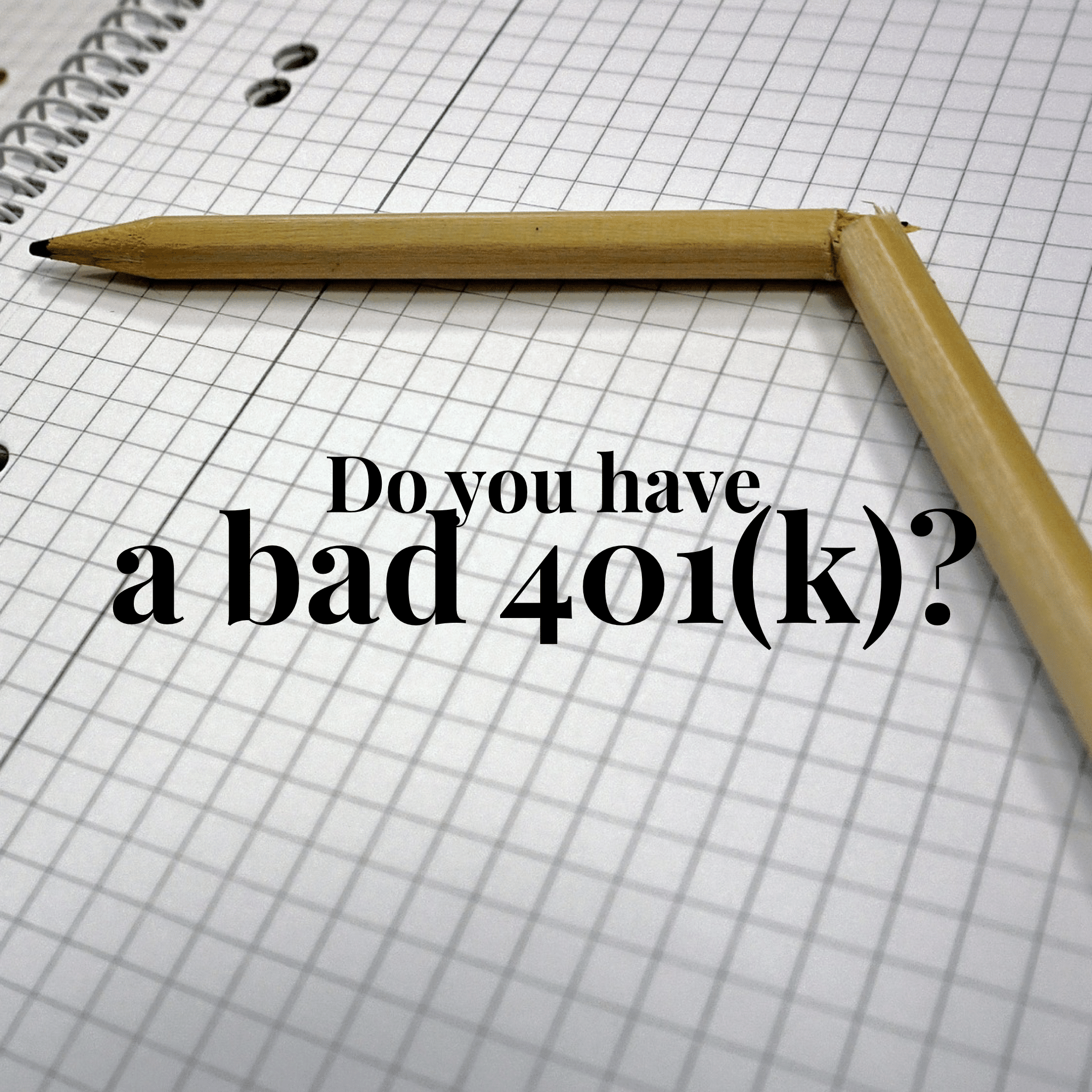When I first meet a potential client, I’m always disheartened to see the poor retirement plans offered by employers.
Most people don’t have the training to identify whether their company is providing them with a good option. Even worse, employees have very little control over their retirement plan options.
While classifying a retirement plan as “good” or “bad” is partly a matter of opinion, there are several items that you can objectively evaluate to determine if you have a bad 401(k) plan. Here’s what to look out for:
High Fees
Most 401(k) plans have a variety of fees. The expense ratio of the funds is the most commonly recognized one, but there are also fees that go to the investment advisor, the record keeper, and the third-party administrator of the plan.
Fee disclosure is required by law, but that doesn’t necessarily mean fees are easy to spot and understand. Sometimes fees are broken out; other times they’re wrapped together. And most people don’t know what a reasonable fee for a 401(k) plan really is. So where should you start?
When you get your statement, look at the total cost of being a participant in your plan. Fees paid by participants in small company 401(k)s are typically higher than those workers at large companies, because large companies can spread the administrator and record keeping costs across more people. Smaller plans (less than 50 employees) might expect to see total cost around 1.00%, but larger plans ought to be cheaper than that.
Poor Investment Lineup
There are many things that can make an investment lineup poor. My biggest pet peeve is seeing a mutual fund lineup that only includes actively managed funds.
Traditional active management uses security selection and market timing in an attempt to beat a benchmark such as the S&P 500, MSCI EAFE or Barclays Aggregate Bond Index. While active management sounds appealing, since the idea is to beat the market, the failure of active management is well documented.
Another characteristic of a poor fund lineup is too many fund options. Plenty of research shows more choice is not better. There are very few plan participants that are savvy enough to properly diversify when given too much choice. Too much choice can even lead investors to feel so overwhelmed that they do something worse than make poor decisions: they choose nothing at all. A good plan doesn’t need more than 15 funds.
Perhaps the worst thing to see with an investment lineup that mostly offers annuities. This is more commonly seen in the 403(b) space. Annuities tend to be more expensive than mutual funds with similar exposures and they have far less flexibility when you change employers or withdraw your money in retirement.
Finally, no matter how good the fund lineup is, building a portfolio without any training is setting people up for failure. A good plan will include model portfolios or target date funds that cost less than 0.30% and don’t rely on proprietary products from the investment advisor.
Lack Of Employer Contributions (Or The Wrong Kind)
One of the best opportunities for savers to double their money is through an employer match within their 401(k). Plans with very generous employer contributions (at least 6%) can offset other poor features such as high cost and poor investment options.
The best plans have matches that vest immediately, giving you the flexibility to eventually move to a new plan or roll your plan into an IRA if you leave the company. Plans without a matching contribution often make contributions to a IRA or Roth IRA more attractive if you have to choose between one or the other.
Some 401(k) plans also offer a profit sharing contribution. A lack of a profit sharing contribution doesn’t make a plan “bad,” but the presence of one is a very good feature. Most plans with profit sharing contributions have vesting schedules of five to seven years.
Many companies make contributions using company stock, but too many people allow this stock to accumulate to a level that creates unnecessary risk. Familiarity with your company’s operations and the perceived of control you have over company performance frequently results in people owning too much company stock in their 401(k).
Similarly, confirmation bias leads to investors focusing on the company’s positives more than potential risks results in people owning too much company stock in their 401(k).
What To Do If You Have A Bad Plan
If your employer doesn’t have a good plan, the first step is to email your HR representative or the company’s Chief Financial Officer. Identifying some of the poor characteristics described in this article is great, but you should also ask questions like:
- How does our plan’s all-in cost compare to similar plans?
- Why aren’t we using mutual funds with lower expense ratios?
- How are you benchmarking our record keeping and administrative costs to other firms?
- Does our company outsource or share its fiduciary duty to the plan participants?
These are all questions that should be answered clearly. If not, then you might consider prioritizing an IRA or consider self-directing your investments if that option is available.















